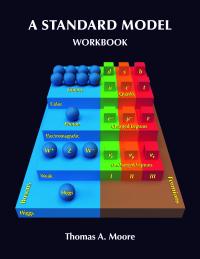A Standard Model Workbook
A Standard Model Workbook
By: Thomas A. Moore
For all sales outside of the United States, please contact Felicity Henson, fhenson@aip.org
Title information
This introduction to the Standard Model of particle physics provides students with a classroom-tested workbook to optimize learning this material in student-centered classes. Developed to support a one-semester upper-level undergraduate or graduate course, it includes hundreds of homework problems that will guide students to a clear understanding of this fascinating field.
Preface
Chapter 1. Introduction
Section I. Relativity
Chapter 2. Special Relativity
Chapter 3. Index Notation
Section II. Classical Fields
Chapter 4. A Classical Scalar Field
Chapter 5. The Klein-Gordon Equation
Chapter 6. Noether’s Theorem
Section III. Quantum Mechanics
Chapter 7. Basic Quantum Mechanics
Chapter 8. Operators and Time Evolution
Chapter 9. Angular Momentum
Shortcut to 15
Chapter 10. Feynman Diagram Quick Start
Section IV. Quantum Field Theory
Chapter 11. Creation and Annihilation Operators
Chapter 12. The Quantized Scalar Field
Chapter 13. Interactions and Feynman Diagrams
Section V. Connection to Experiment
Chapter 14. Fermi’s Golden Rule
Chapter 15. Toy Universe Predictions
Section VI. Spin – ½ Particles
Chapter 16. The Dirac Equation
Chapter 17. Transforming Dirac Spinors
Chapter 18. Quantizing the Dirac Field
Section VII. The Electroweak Theory
Chapter 19. Electromagnetism from U(1)
Chapter 20. Quantum Electrodynamics
Chapter 21. Renormalization
Chapter 22. Applications of QED
Chapter 23. The Weak Interaction from SU(2)
Chapter 24. The Weak Interaction’s Leftist Bias
Chapter 25. The Unified Electroweak Theory
Section VIII. Particle Masses
Chapter 26. The Higgs Mechanism
Chapter 27. Fermion Masses and Mixing
Chapter 28. Neutrino Masses and Mixing
Chapter 29. Applications of the Electroweak Theory
Section IX. Chromodynamics
Chapter 30. Chromodynamics from SU(3)
Chapter 31. Applications of QCD
Section X. And Beyond!
Chapter 32. Beyond the Standard Model
Appendix
Appendix A. Potentials From Interactions
Index
|
“Moore blends clear and efficient prose with well-chosen exercises that are an essential part of the exposition, helping students build both fluency with the concepts and facility with the calculations. This workbook guides the student from first steps to the sort of mastery through computation that is prized by working physicists.” "I found this textbook to be a delightful overview of particle physics for an undergraduate course. Moore clearly understands his student audience and their capabilities/limitations, and tunes the pacing and parceling of the material accordingly." |
Thomas A. Moore
Thomas A. Moore is a professor in the physics department of Pomona College. He graduated from Carleton College in 1976, and earned an M. Phil. in 1978 and a Ph. D. in 1981 from Yale University. He then taught at Carleton College and Luther College before taking his current position at Pomona College in 1987, where he won a Wig Award for Distinguished Teaching in 1991. He served as an active member of the national Introductory University Physics Project (IUPP), and has published a number of articles about astrophysical sources of gravitational waves, detection of gravitational waves, and new approaches to teaching physics. His previous books include A Traveler's Guide to Spacetime (McGraw-Hill, 1995) on special relativity, and a six-volume introductory calculus-based physics text called Six Ideas That Shaped Physics (McGraw-Hill, 2003).

